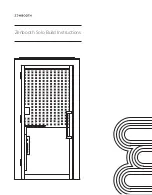
18
Subject to change without notice
The slope of the leading edge of the synchronization pulse
is critical for the
SLOPE
pushbutton setting. If the displayed
sync pulses are
above
the picture (field) contents, then
the SLOPE pushbutton (±) must be in
+
position (out). In
the case of sync pulses
below
the field/line, the leading
edge is negative and the SLOPE pushbutton must therefore
be depressed (to “
–
”). Since the
INVERT
function may
cause a misleading display, it must not be activated until
after correct triggering is achieved.
On the 2ms/div setting field TV triggering is selected and
1 field is visible if a 50 fields/s signal is applied. If the hold
off control is in fully ccw position, it triggers without line
interlacing affects caused by the consecutive field. More
details in the video signal become visible if the
X-MAG.
(x10)
pushbutton is depressed (in). The
X-POS
. control
allows to display any part of the expanded signal. The
influence of the integrating network which forms a trigger
pulse from the vertical sync pulses may become visible
under certain conditions.
Disconnecting the trigger circuit (e.g. by rapidly pressing
and releasing the
EXT.
button) can result in triggering the
consecutive (
odd
or
even
) field.
On the 10µs/div setting line TV triggering is selected and
approx. 1½ lines are visible. Those lines originate randomly
from the odd and even fields.
The sync-separator-circuit also operates with external
triggering. It is important that the voltage range (0.3V
pp
to
3V
pp
) for external triggering should be noted. Again the
correct slope setting is critical, because the external
trigger signal may not have the same polarity or pulse
edge as the test signal. This can be checked, if the
external trigger voltage itself is displayed first (with internal
triggering).
In most cases, the composite video signal has a high DC
content. With constant video information (e.g. test pattern or
color bar generator), the DC content can be suppressed
easily by
AC
input coupling of the oscilloscope amplifier.With
a changing picture content (e.g. normal program),
DC
input
coupling is recommended, because the display varies its
vertical position on screen with AC input coupling at each
change of the picture content. The DC content can be
compensated using the
Y-POS.
control so that the signal
display lies in the graticule area. Then the composite video
signal should not exceed a vertical height of 6div.
Line triggering (~)
A voltage originating from mains/line (50 to 60Hz) is used
for triggering purposes if the
TRIG.
switch is set to
~
. This
trigger mode is independent of amplitude and frequency of
the Y signal and is recommended for all mains/line
synchronous signals. This also applies within certain limits
to whole number multiples or fractions of the line frequency.
Line triggering can also be useful to display signals below the
trigger threshold (less than 0.5div). It is therefore particularly
suitable for measuring small ripple voltages of mains/line
rectifiers or stray magnetic field in a circuit. In this trigger
mode the
SLOPE
pushbutton selects the positive or negati-
ve portion of the line sinewave. The
LEVEL
control is used for
trigger point adjustment in case of normal triggering (
AT/
NORM
. depressed).
Magnetic leakage (e.g. from a power transformer) can be
investigated for direction and amplitude using a search or
pick-up coil. The coil should be wound on a small former
with a maximum of turns of a thin lacquered wire and
connected to a BNC connector (for scope input) via a
shielded cable. Between cable and BNC center conductor
a resistor of at least 100
Ω
should be series-connected (RF
decoupling). Often it is advisable to shield statically the
surface of the coil. However, no shorted turns are
permissible. Maximum, minimum, and direction to the
magnetic source are detectable at the measuring point by
turning and shifting the coil.
Alternate triggering
With
alternate triggering
(
ALT.
button depressed) it is
possible to trigger two signals which are different in frequency
(asynchronous). In this case the oscilloscope must be operated
in
alternate DUAL
mode with signals of sufficient height at
each input. To avoid trigger problems due to different DC
voltage components,
AC
input coupling for both channels is
recommended.
The internal trigger source is switched in the same way as
the channel switching after each time base sweep.
Phase difference measurement is not possible in this
trigger mode.
External triggering
The internal triggering is disconnected by depressing the
TRIG. EXT.
button. The timebase can be triggered
externally via the
TRIG. INP.
socket using a 0.3V
pp
to 3V
pp
voltage, which is in syncronism with the test signal. This
trigger voltage may have completely different form from
the test signal voltage. Triggering is even possible in
certain limits with whole number multiples or fractions of
the test frequency, but only with synchronous signals.
The input impedance of the TRIG. INP. socket is approx.
100k
Ω
II 10pF. The maximum input voltage of the input
circuit is 100V (DC+peak AC).
It must be noted that a different phase angle between the
measuring and the triggering signal may cause a display
not coinciding with the
SLOPE
pushbutton setting.
The trigger coupling selection can also be used in external
triggering mode. Unlike internal triggering, the lowest
frequency for external triggering is 20Hz in all trigger
coupling conditions.
Trigger indicator
An LED on condition (above the TRIG. switch) indicates
that the trigger signal has a sufficient amplitude and the
LEVEL control setting is correct. This is valid with automatic
and with normal triggering. The indication of trigger action
facilitates a sensitive LEVEL adjustment, particularly at
very low signal frequencies. The indication pulses are of
only 100ms duration.














































